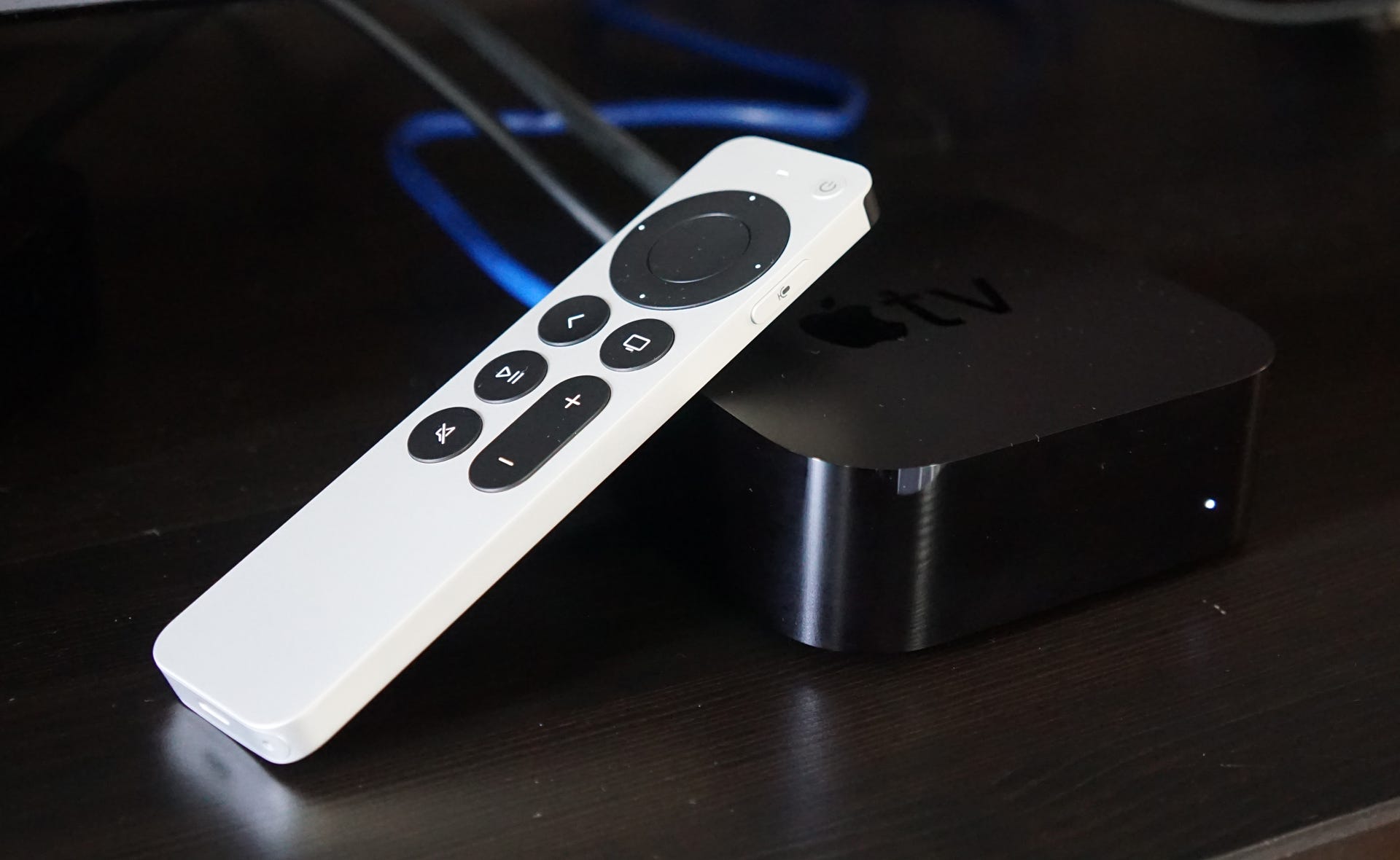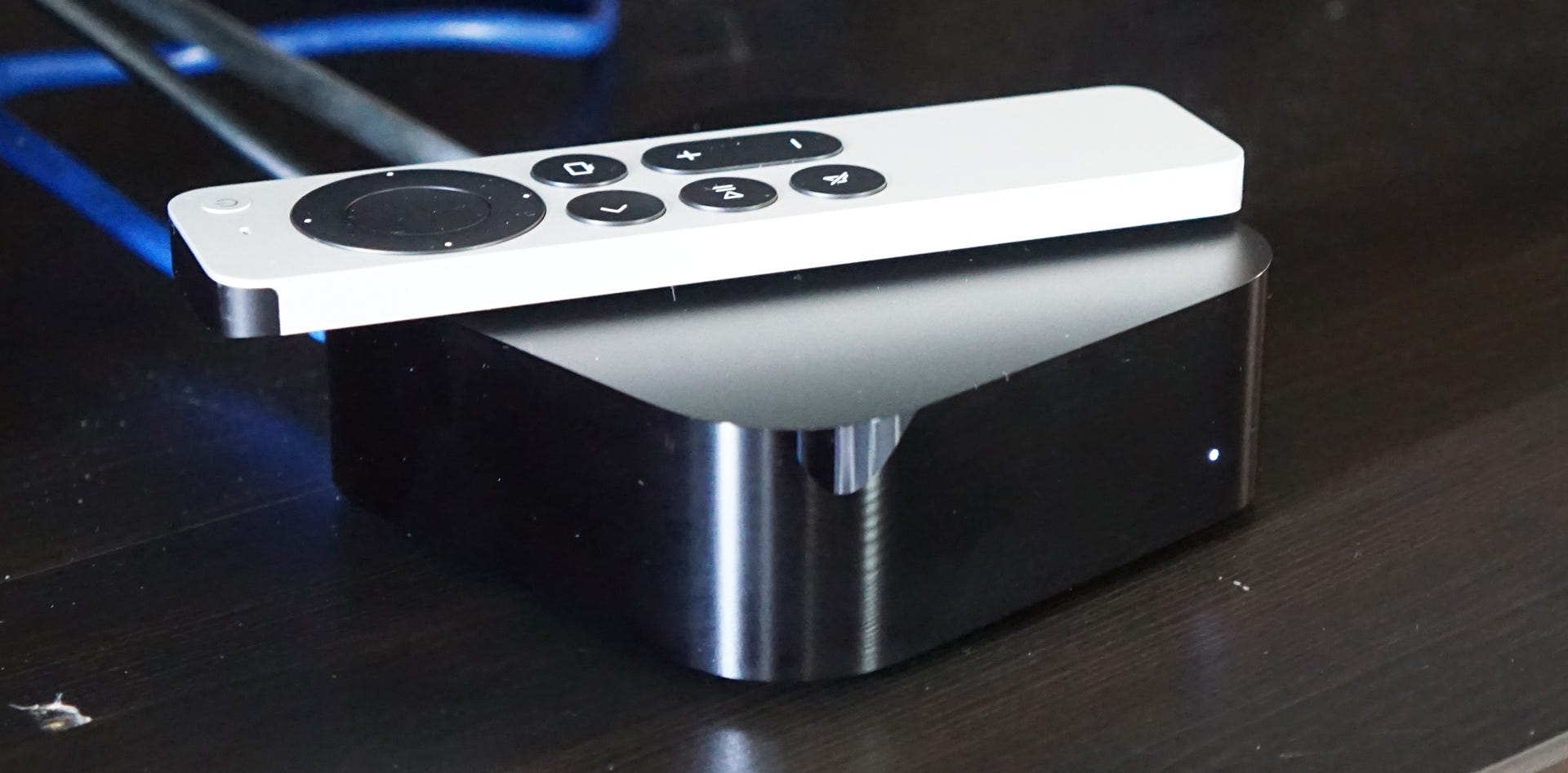This reasonable update essentially rights a utility wrong

The second-generation Apple TV 4K pumps up the power with one of Apple’s aging CPUs (A12 Bionic), adding support for higher frame rates, better Wi-Fi, and an intriguing color balancing tool. But all I can think about is the new Siri remote.
Forgive me if I’m not doing backflips over what is essentially a minor streaming-box update paired with a fundamental redesign of the most important element in your streaming experience.
To understand my fixation with the new, bulkier, and more workmanlike Apple TV 4K Siri remote, you need to understand the enmity most people have toward the previous remote. A mix of metal, plastic, and glass, it was a slippery bugger that offered almost no tactile clues about whether you were holding it correctly or backward. Usually, you found out when the touch-sensitive glass ended up buried in your palm, hurtling your Netflix binge backward in time.
Apple never said the remote was bad, but the new look is an admission in and of itself.
The thing you hold
The new, almost all-aluminum remote is taller and thicker than the last one. It might also be a tad narrower. There is no glass that I can see. Instead, the remote was redesigned with eyes-free use in mind. What I mean is that you no longer have to look at the remote to use it. From the top down: There’s a tiny slot for the microphone. To the left is the new power button that can put your Apple TV 4K and TV to sleep with one press or turn them off with a long press.

Below that is the large clickpad with a touch surface. The large touch-sensitive button in the center is great for controlling video playback and scrubbing back and forth through a video stream. The outer circle is good for larger jumps through videos and menus. The entire circular button is touch-sensitive, but I could see people doing as I did, keeping their gestures confined to the center circle and pressing on the outer ring for bigger tasks.
Next, you have the self-explanatory Back button next to the familiar Apple TV button (a long press takes you to the Control Center and lets you switch user accounts). Below those buttons on the right is a large volume rocker. It sits next to Play/Pause and a new Mute button.
As for Siri, the button is now on the side of the remote. (Yes, like your iPhone.) Instead of saying, “Hey Siri,” you press and hold while you make your Siri request.
At the bottom is a Lightning port for charging the remote.
To say I like this new remote is an understatement. It solves virtually every issue I had with the old one. It’s easier to hold, harder to lose, and almost impossible to break. (I once shattered the glass of an older Apple TV remote when I dropped in on cement.)

It’s worth noting that this design is something of a throwback. I still have my second-generation Apple TV remote. Like this new one, it’s all aluminum and even has the five-way button at the top; however, the button isn’t touch-sensitive. This old remote can control the new Apple TV 4K. It’s not perfect, but it works.
The only downside to this new remote is that it jettisons the accelerometer, making the model useless when it comes to Apple Arcade gameplay. Fortunately, it’s easy to pair an Xbox One Bluetooth remote with the new Apple TV.
I know, a huge digression into the new remote, but if you read no further, know that it’s worth the price of admission, and if you happen to own an old Apple TV 4K, you can buy just this remote for $59.
Set it up
Setting up my new Apple TV 4K—which is the exact same design as the previous one, right down to the vents on the bottom—was easy. The system walked me through a couple of screens, and then let me use my iPhone to transfer my credentials. This significantly shortened the process, and I only had to reauthorize a handful of my streaming accounts.

One of this streaming box’s big new features is the ability to tune your TV’s color balance for you. My TV already has Dolby Vision, which the Apple TV 4K supports. As a result, it didn’t need tuning—the Apple TV 4K interface told me so. Even so, I turned off Dolby Vision so I could try out the calibration. It wasn’t worth it.

In theory, this is a cool idea. Once you start the color balance process, the Apple TV box instructs you to hold your iPhone close to the screen. My phone then asked me to continue the process, which entailed me pointing my iPhone’s face and TrueDepth camera at the screen, holding it approximately one-inch away from my 65-inch TV screen.

At this point, a block of color in the shape of a phone appeared on the TV screen. As the system cycled through a series of colors, I had to hold the phone in place. This was harder than I thought, and I failed a couple times before holding the phone still long enough to get a full reading.
With that done, Apple TV made the necessary color-tuning adjustments and then asked if I wanted to accept the changes. As far as I could tell, this process did not improve my image. In the end, I turned Dolby Vision back on.
More power
Apple TV 4K’s new processor gives it ample power to support things like Wi-Fi 6 and High Frame Rate HDR, which will come in handy if you like to watch sports or action movies, all of which can smear if the frame rate can’t keep up.
Not a lot of shows currently support High Frame Rate HDR, but I did find some content on the Red Bull app. In particular, I started watching some high-speed skate racers. (Or was it skate roller derby? I couldn’t tell) As the racers slid around the frosty Quebec track, they did look a bit sharper. Until there’s more support for this format, High Frame Rate HDR is not a reason to buy a new Apple TV.
Siri
I did have a good time with the Siri remote. I could use it to quickly find content (“Find shows starring Amy Adams,” “Show me action movies”). I could ask it to play music or questions about the weather in my town and around the world. I also used it to get stock reports and to control my HomeKit devices. It’s too bad so many of my smart home devices are from Google/Nest and Amazon and can’t be controlled with Siri. If you have a HomeKit video doorbell — I do not — you can now see your doorbell visitor video as a picture-in-picture on your Apple TV playback.
I like how easy it is now to connect accessories to my Apple TV experience. I have all my Apple TV 4K audio playing through an original HomePod and could choose to use a pair of HomePod minis instead.

I had no trouble pairing my Apple AirPods, nor was it difficult to connect an Xbox One controller. I used both to quietly play a Sonic racing game in Apple Arcade.
I appreciate that I can also use my other Apple services through the box, like Apple Music and Fitness+. My living room, however, is not where I want to work out.
More for your money
Apple TV 4K starts at $179 (32 GB) and $199 (64 GB). This is not the most affordable 4K streaming box. Still, it does more than many, integrating gaming, fitness, and music. If you’re already an Apple house, it slips neatly into the Apple ecosystem and enhances everything from entertainment to smart home technology control.
I like Apple TV and the home screen that automatically synchronizes across multiple Apple TV systems and even cleans up unused apps. It’s a sharper look and certainly less whimsical than what you get from Roku. Do I like it more? I’m not sure. I will say that I now like the Apple TV remote at least as much as Roku’s, if not more. It’s the best redesign Apple’s done in years.
"TV" - Google News
May 20, 2021 at 08:17PM
https://ift.tt/341fBqy
Apple TV 4K Second-Gen Review: It's All About the Remote - Medium
"TV" - Google News
https://ift.tt/2T73uUP
Bagikan Berita Ini














0 Response to "Apple TV 4K Second-Gen Review: It's All About the Remote - Medium"
Post a Comment